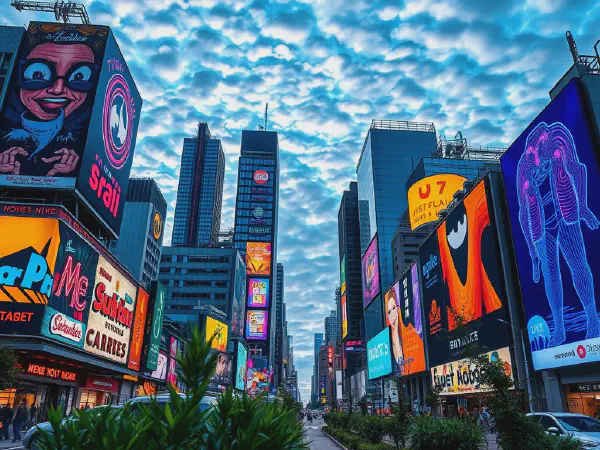Exploring the World of Gigantic Signs: Impact and Design

Gigantic Signs: A Bold Statement in Advertising and Culture
Gigantic signs have become an iconic aspect of modern urban landscapes, serving as powerful symbols of branding and marketing. These monumental structures, often towering high above streets and buildings, capture attention and evoke curiosity. Gigantic signs are not just mere advertisements; they are a blend of art, commerce, and cultural expression. Their scale and presence invite exploration and engagement, making them a vital part of the advertising ecosystem.
The history of gigantic signs can be traced back to the early 20th century, with companies recognizing the importance of visibility in attracting customers. As cities grew and competition intensified, businesses began to invest in larger and more elaborate signs to stand out. The evolution of gigantic signs reflects broader trends in marketing strategies and consumer behavior, showcasing how brands adapt to the changing urban environment. Gigantic signs have since evolved from traditional painted billboards to innovative digital displays that can be updated in real time.
The effectiveness of gigantic signs in influencing consumer behavior cannot be understated. Research has shown that larger signage attracts more attention, leading to higher recall rates and increased foot traffic. Brands harness the psychological impact of size; the bigger the sign, the greater the perceived importance of the brand or message. Case studies reveal how iconic gigantic signs have transformed local businesses, increased sales, and created lasting impressions in consumers’ minds, positioning them as essential marketing tools.
In comparison to traditional signage, digital gigantic signs have revolutionized the advertising space. Traditional signs may be visually striking but lack the interactivity and dynamic nature offered by digital formats. Digital gigantic signs can display animations, promotions, and messages that engage audiences in real-time, establishing a dialogue between the brand and the consumer. This comparative analysis showcases the shift towards technology-driven advertising methods in urban settings, where both forms have their unique advantages and roles.
Gigantic signs often serve not only practical purposes but also aesthetic functions, reflecting the character of the city and its identity. The design and aesthetics of these structures combine creativity with engineering, resulting in visually stunning installations that captivate viewers. Designers must balance size with readability, ensuring that messages are clear from a distance while still being artistically appealing. This delicate balance between function and form is crucial in creating successful gigantic signs that stand the test of time.
Advertising Impact of Gigantic Signs
Historically, the use of gigantic signs in advertising dates back to the late 19th century when businesses recognized the potential of large visual elements to attract attention. Initially, signs were hand-painted, but as technology evolved, so did the materials and techniques used. The rise of neon signs in the 1920s marked a turning point, as brightly lit, eye-catching designs became a staple in urban areas. These gigantic signs began to define city skylines, illustrating the strong connection between architecture and commercial identity.
The effectiveness of large signage on consumer behavior is evident in studies showing increased brand recall and customer foot traffic. Larger signs are often associated with greater brand authority and trust. This impact is not only immediate but also long-lasting, as consumers tend to remember brands linked to iconic signs. For example, the famous Hollywood Sign has become synonymous with the entertainment industry, enhancing the area's attractiveness and business opportunities.
Several successful gigantic sign campaigns demonstrate their advertising power. For instance, the Times Square in New York City is renowned for its vibrant assortment of gigantic digital signs, which have significantly boosted tourism and local businesses. Brands like Coca-Cola and Samsung utilize these signs to create visually appealing advertisements that resonate with the public, establishing brand loyalty and recognition across generations.
A comparative analysis of traditional vs digital gigantic signs reveals the transition in advertising strategies. While traditional signs create a nostalgic appeal, digital signs offer flexibility, interactivity, and data-driven insights. Traditional sign designs are often static and require more resources for updates, whereas digital signs can be altered instantly to accommodate changing market demands, seasonal promotions, or special events, making them a contemporary favorite.
Design and Aesthetics of Gigantic Signs
The design of gigantic signs encompasses various elements, including typography, color, imagery, and structural integrity. Designers must consider the viewing distance and angle to ensure that the message is legible and impactful. Creative use of space and visual hierarchy enhances the overall aesthetic, making the sign not only communicative but also artistically pleasing. Furthermore, designers often draw inspiration from local culture and history, embedding a regional identity within the sign's design.
Balancing size and readability is paramount in the design of gigantic signs. While larger sizes can draw attention, they can also pose challenges with readability if not designed correctly. Factors such as font choice, spacing, and visual contrast inform how effectively the message can be perceived from various distances. Designers must conduct thorough testing to guarantee that the sign communicates its intended message clearly and instantly, regardless of the viewer's location.
Innovative materials play a crucial role in the design and longevity of gigantic signs. Advances in printing technology, lightweight materials, and sustainability options allow designers to create large-scale installations that are not only striking but also durable and environmentally friendly. Materials such as aluminum, LED screens, and acrylics contribute to the versatility and appeal of gigantic signage, paving the way for more dynamic and engaging designs.
Color and lighting significantly influence the aesthetics of gigantic signs, as they can set the mood and convey brand identity. The use of bold colors can make a sign more noticeable, while clever lighting enhances visibility during nighttime. Designers often collaborate with lighting experts to create captivating displays that change throughout the day, allowing for a dynamic visual experience that attracts attention and enhances branding efforts.
Cultural and Historical Significance
Iconic gigantic signs around the world serve as cultural landmarks and symbols of their respective cities. For instance, the 'Welcome to Fabulous Las Vegas' sign is not only an advertising tool but also a piece of cultural heritage that represents the city's identity. Similarly, the 'Moulin Rouge' sign in Paris reflects the artistic spirit of the Montmartre district, commemorating the vibrant entertainment industry. Such signs transcend their original marketing purposes, becoming integral parts of the cities’ visual landscapes and cultural narratives.
Gigantic signs convey powerful cultural messages, often representing values, aspirations, and local pride. For communities, these signs can foster a sense of identity and belonging, celebrating local traditions and histories. For instance, the 'I Love NY' sign captures the spirit of New York City, symbolizing unity and vibrancy among residents and visitors alike. Such cultural narratives are embedded within the design and messaging of gigantic signs, resonating with audiences on a personal level.
The evolution of gigantic signs through history mirrors the advancement of technology, urban development, and marketing strategies. From painted wooden signs to neon lights and digital displays, the transformation showcases shifts in consumer engagement and branding methodologies. This evolution is closely tied to societal changes, such as the rise of consumerism and the digital age, highlighting how gigantic signs adapt to both technological advancements and cultural shifts.
As gigantic signs have evolved, some have become recognized landmarks and tourist attractions. Tourist hotspots such as the Hollywood Sign and the iconic Piccadilly Circus display have drawn millions of visitors worldwide, showcasing their significance beyond mere advertising. These signs play a vital role in shaping the tourism industry, contributing to local economies and serving as must-see destinations in their own right.
Legal and Safety Considerations
The installation of gigantic signs is subject to regulations aimed at maintaining public safety and urban aesthetics. Local governments often have strict zoning laws that dictate where signs can be placed, their size, and even their illumination. These regulations ensure that gigantic signs do not obstruct views or create hazards for pedestrians and motorists. Compliance with these laws is essential for businesses to avoid penalties and ensure the safety of the public.
Safety protocols for constructing gigantic signs involve rigorous planning and execution. The structural integrity of a gigantic sign must be ensured through engineering analysis and the use of durable materials to withstand environmental factors such as wind and rain. Additionally, professional installation by licensed contractors is crucial to guarantee that signs are erected safely and meet all legal standards, minimizing risks for both workers and the public.
The impact of gigantic signs on urban aesthetics and planning is a critical consideration for city developers and planners. While these signs enhance visibility and connectivity for businesses, they also raise concerns about visual clutter and urban sprawl. Thoughtful integration of gigantic signs into urban landscapes is necessary to maintain a balanced visual appeal while promoting commerce and tourism, fostering a sense of place and identity.
Environmental considerations for gigantic signs have gained importance in recent years as cities strive for sustainability. The use of eco-friendly materials and energy-efficient lighting solutions, such as LED technologies, contributes to minimizing the environmental impact of these installations. Furthermore, community engagement in the design process can help ensure that gigantic signs align with local values and promote an environmentally conscious culture.
Technological Innovations in Gigantic Signs
Advancements in LED technology have transformed the landscape of gigantic signs, making them brighter, more versatile, and cost-effective. LED displays offer improved visibility from great distances, consume less energy, and have longer lifespans compared to traditional lighting methods. With the ability to display dynamic content, brands can create engaging and memorable experiences for consumers, further enhancing the effectiveness of their advertising strategies.
The emergence of interactive gigantic signs has opened new avenues for user engagement. Technology such as QR codes, augmented reality, and touch-screen interfaces allow consumers to interact with the signage and experience personalized messages or promotions. This interactivity not only boosts consumer interest but also gathers valuable data for brands, enabling tailored marketing efforts that resonate with targeted audiences.
Future trends in gigantic sign design and technology indicate a shift towards even more personalization and sustainability. As technology continues to advance, we can expect to see smarter installations that utilize real-time data to adjust content based on audience demographics and preferences. Furthermore, the push for eco-friendly designs will likely influence materials and energy sources, leading to more responsible advertising practices in urban environments.
Utilization of data analytics in sign placements has become increasingly relevant as brands seek to maximize their advertising impact. Data-driven insights regarding audience behaviors and traffic patterns allow businesses to choose optimal locations for their gigantic signs, ensuring they reach their target demographics effectively. This analytical approach will continue to shape the future of gigantic signs, merging creativity with strategic planning in the advertising landscape.
